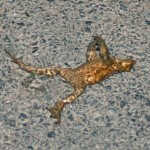Toads generally spawn later than frogs in my area, but this is very dependant on weather. Mild winters lead to earlier spawning and migrations to ponds can occur as early as the last week in February. Watch my video of the mating scramble here.
Usually toads will start making the move to their breeding ponds on dry nights after a bout of rain, when the temperature is at least a 6 degrees above freezing (Reading 1998). Spawning times can vary from one garden to another in the same street. The full moon may encourage large arrivals of toads and big spawning events. It’s not clear why – extra light may help them find their way to the pond or may deter predators, or possibly they have some kind of inner t ime clock (Grant et al., 2009)
ime clock (Grant et al., 2009)
Almost all toads return to their native pond even when there are several alternative ponds nearby. They orientate themselves by smell of their native pond though their sensitivity to this may not operate outside the breeding season (Ogurtsov 2004). Occasionally, if they have mated with a female from a different pond before arriving at their native pond, they may switch ponds. Or if their original pond has dried up or been filled in they may search for a new one. This means, however, that most of the time the toads in one pond will be a self-contained population. They are not flexible enough to adapt well to change (Reading et al. 1991)
Alas, in staying faithful to their native pond, they sometimes have to crawl slowly for up to a mile and three quarters (Mattison 2011), sometimes across busy roads and scores of these small animals are just squashed by passing traffic. In the UK there are toad crossing points manned by volunteers who lift them across the road – find them here. The males will latch on to the females as soon as they see them, so the females sometimes have to crawl carrying the weight of the male. Once they are in the pond, the males scramble to get a female. Only about one in five of the males gets the chance to breed, about about a third of these have done so by pushing off a smaller male (Davies & Halliday, 1979) – amplexus interruptus, so to speak.
to breed, about about a third of these have done so by pushing off a smaller male (Davies & Halliday, 1979) – amplexus interruptus, so to speak.
REFERENCES
Davies, N. B. & Halliday, T. R., (1979), ‘Competitive mate searching in male common toads Bufo bufo,’ Animal Behaviour, 27, 1253-1267
Grant, R.A., Chadwick, E. A. & Halliday, T., (2009) ‘The lunar cycle: a cue for amphibian reproductive phenology?’ Animal Behaviour, 78, 349–357.
Mattison, C.,(2011), Frogs and Toads, London, UK, Natural History Museum.
Ogurtsov, S. V. (2004), ‘Olfactory orientation in anuran amphibians, Russian Journal of Herpetology, 11, 35-40
Reading, C.J.,(1998), ‘The effect of winter temperatures on the breeding activity in the common toad, Bufo bufo, Oecologia, 117, 469-475
Reading, C.J., Loman, J. & Madse, T., (1991), ‘Breeding pond fidelity in the common toad, Bufo bufo,‘ Journal of Zoology, 225, 201-21 1